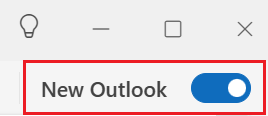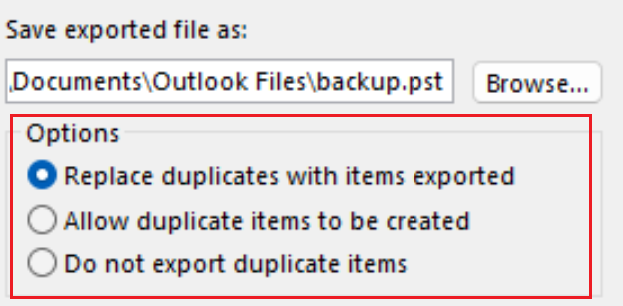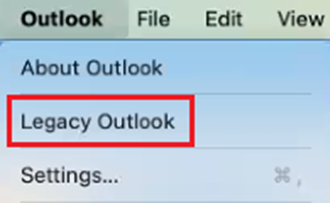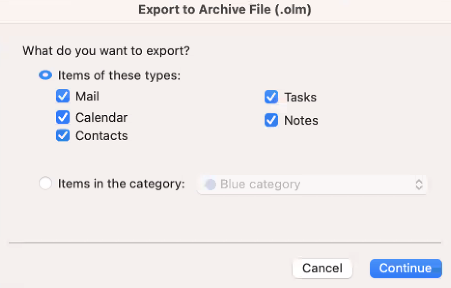Mengekspor atau mencadangkan kontak, kalender, email, dan tugas saya
Catatan: Petunjuk ini hanya untuk referensi. Pemandu GoDaddy kami tidak dapat membantu Anda mengekspor data.
Buat file pencadangan Outlook untuk menyimpan dan mengekspor pesan email, kontak, info kalender dan tugas. Kemudian impor pencadangan Anda ke paket email baru, layanan email, atau versi baru Outlook. Ekspor tidak akan menyertakan meta-data seperti properti folder (tampilan, izin, dan pengaturan AutoArchive), aturan pesan, serta daftar pengirim yang diblokir. Perlu diperhatikan bahwa Microsoft tidak lagi mendukung versi Outlook yang lebih lama dari tahun 2016.
Wajib: Untuk memastikan seluruh kotak surat Anda diekspor, nonaktifkan mode Cached Exchange, jika tidak, ekspor hanya akan menyertakan 12 bulan terakhir.
Pilih tab yang sesuai berdasarkan platform email yang Anda gunakan.
- Masuk ke Outlook di web. Gunakan alamat email dan kata sandi Microsoft 365 (nama pengguna dan kata sandi GoDaddy tidak akan berfungsi di sini).
- Di sisi paling kiri halaman, pilih
 Orang.
Orang. - Pilih Kelola kontak, lalu Ekspor kontak.
- Pilih jika Anda ingin mengekspor semua kontak atau kontak dari folder tertentu saja, lalu pilih Ekspor.
Kontak Anda akan disimpan sebagai file .csv, yang bisa Anda impor ke aplikasi email lain (seperti Gmail) atau Outlook versi lain.
- Buka Outlook.
- Jika Anda menggunakan Outlook versi baru, kembalikan ke Outlook klasik. Di sudut kanan atas, nonaktifkan tombol Outlook Baru. Anda mungkin harus mengonfirmasi bahwa Anda ingin beralih.

- Di pojok kiri atas, pilih File.
- Pilih Buka & Ekspor, lalu Impor/Ekspor.
- Pilih Ekspor ke file, lalu Berikutnya.
- Pilih File Data Outlook (.pst), lalu Berikutnya.
- Untuk mengekspor seluruh kotak surat, pilih nama akun email dan lanjutkan ke langkah berikutnya. Atau, untuk mengekspor kalender, kontak, atau tugas saja, pilih folder yang ingin Anda ekspor. Anda hanya dapat mengekspor satu jenis sekaligus, jadi Anda perlu mengulangi langkah-langkah ini untuk mengekspor kontak, kalender, dan tugas secara terpisah.
- Pastikan kotak centang di samping Sertakan subfolder telah dicentang, lalu pilih Berikutnya.
- Untuk memilih lokasi tempat untuk menyimpan File Data Outlook (.pst), pilih Telusuri. Masukkan nama file, lalu pilih OK.
- Jika Anda mengekspor ke File Data Outlook (.pst) yang sudah ada, di Opsi, tentukan apa yang harus dilakukan saat mengekspor item yang sudah ada dalam file tersebut.

- Pilih Selesai.
- Proses ekspor akan segera dimulai kecuali jika salah satu dari skenario berikut ini berlaku:
- Bila dialog Buat File Data Outlook muncul, masukkan kata sandi di Kata Sandi dan Verifikasi Kata Sandi, lalu pilih OK. Jika tidak, untuk melanjutkan tanpa menyiapkan kata sandi, biarkan kolom kata sandi kosong, lalu pilih OK.
- Jika Anda mengekspor ke File Data Outlook (.pst) yang telah ada dan dilindungi kata sandi, di dalam dialog Kata Sandi File Data Outlook masukkan kata sandi, lalu pilih OK.
- Buka Outlook.
- Jika Anda menggunakan Outlook versi baru, alihkan ke Outlook versi lama. Pilih Outlook, lalu Outlook Lama. Anda mungkin harus mengonfirmasi bahwa Anda ingin beralih.

- Pilih File, lalu Ekspor. Jendela Ekspor ke File Arsip (.olm) akan terbuka.
- Jika Anda tidak melihat Ekspor, pilih Alat, lalu Ekspor.
- Pilih item yang ingin Anda ekspor. Secara default, semua item dipilih.
- Untuk mengekspor salah satu jenis ini secara terpisah, pilih kotak centang di samping setiap item.

- Pilih Lanjutkan .
- Pilih lokasi untuk menyimpan file di komputer, masukkan nama file, lalu pilih Simpan. Item Anda akan diekspor.
- Pilih Selesai.
Langkah terkait
- Kini setelah data Outlook diekspor dalam file cadangan, Anda bisa mengimpornya di Outlook.
Info selengkapnya
- Cari tahu cara mengekspor kalender ke file .ics dari Microsoft.
- Baca lebih lanjut tentang mengekspor dan mengimpor file di Outlook dari Microsoft.
- Lihat artikel ini dari Apple untuk mempelajari cara mengimpor atau mengekspor kotak masuk di Apple Mail di Mac.